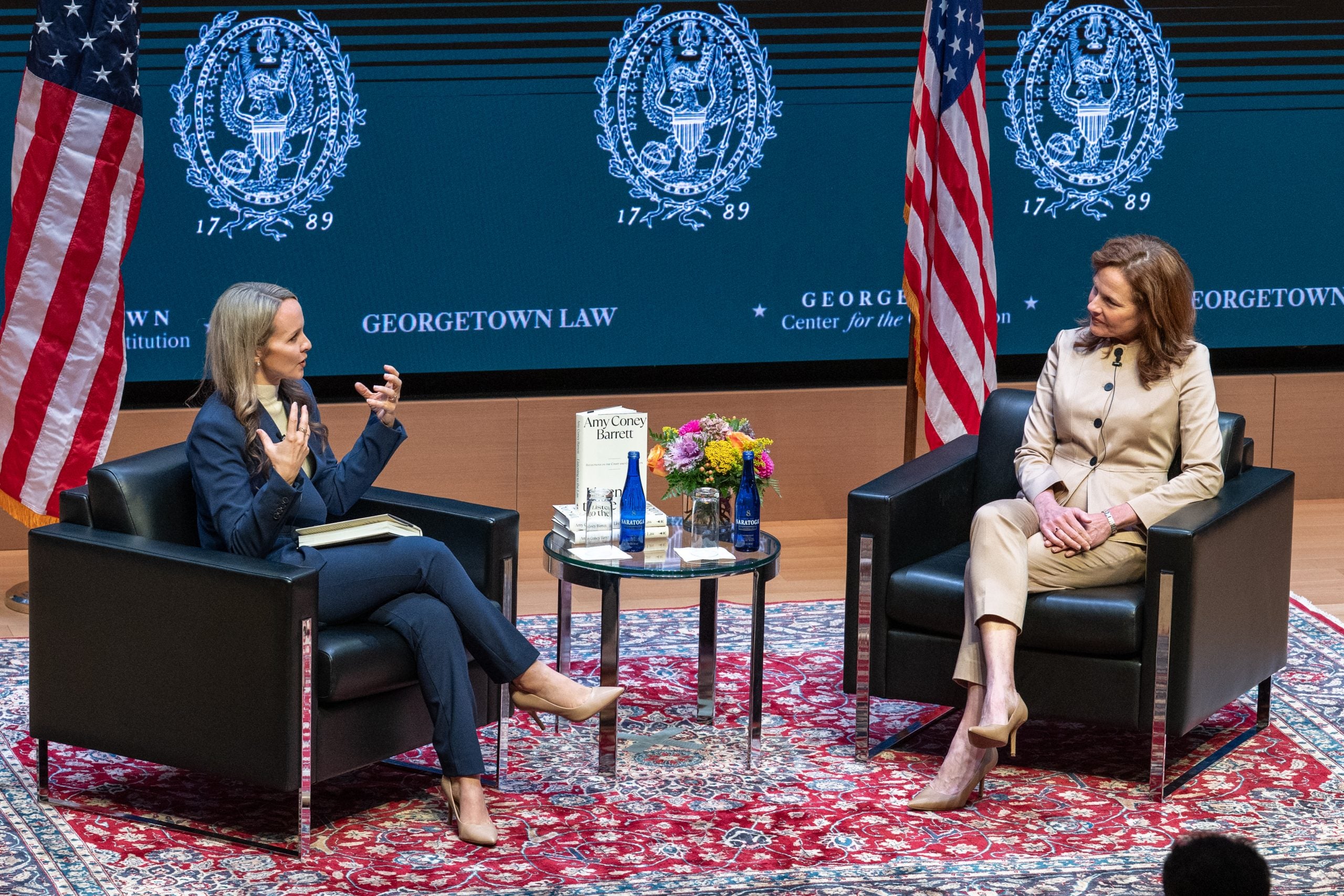‘Engaged in a Common Enterprise’: U.S. Supreme Court Justice Amy Coney Barrett Reflects on Judicial Independence, Transparency
November 5, 2025

U.S. Supreme Court Justice Amy Coney Barrett (right) with Professor Stephanie Barclay (left), faculty co-director of the Georgetown Center for the Constitution.
United States Supreme Court Justice Amy Coney Barrett joined members of the Georgetown Law community on October 28 for a wide-ranging conversation hosted by the Georgetown Center for the Constitution about constitutional interpretation, judicial transparency and collegiality on the nation’s highest court.
“It’s strength of character to be able to be as impervious as possible to what people think about you and what people say about you,” the Justice said in conversation with Professor Stephanie Barclay, faculty co-director of the Georgetown Center for the Constitution, in response to a question about facing criticism.
“If you let criticism get to you, or if you let threats and a lack of popularity get to you, then you will be beholden to the opinion of others, rather than to your job, which is figuring out what the law requires,” she told the audience of students and faculty invited by the Center for the Constitution in Hart Auditorium.
The conversation, in which Justice Barrett also expanded on anecdotes from her new book, Listening to the Law: Reflections on the Court and Constitution, was preceded by introductions by Professor Randy Barnett, faculty director of the Georgetown Center for the Constitution, and Georgetown University Interim President Robert M. Groves.
Originalism and interpretation
In addition to the importance of impartiality among judges, the Justice discussed originalism and her approach to constitutional interpretation, a subject also explored in Listening to the Law.
“Originalism can tell you what the meaning of the text is, but not how it should apply in a given case,” the Justice said in reflecting on jurisprudence in recent cases such as Vidal v. Elster, which involved the application of the First Amendment to trademark law — an area that did not exist at the time of the nation’s founding.
“In my concurrence in that case, I was just trying to separate out this idea that history and tradition is the same as originalism, or that it somehow forms the content of the law, so that it’s binding in the same way as the original meaning,” she said.
Challenges of the emergency docket

U.S. Supreme Court Justice Amy Coney Barrett (right) and Professor Stephanie Barclay (left). A portrait of former First Lady Abigail Adams hangs in her chambers, Justice Barrett shared, as a reminder of the nation’s founding and the history of the United States Constitution. “Abigail Adams, to my mind, is about the closest you can get to a woman founder,” she said.
The Justice also reflected on the role of U.S. Supreme Court opinions in preserving judicial transparency. “Opinions are the Court’s most important work product,” she said. “We don’t just have a vote. We have to show why we voted the way that we did.”
Justice Barrett was also asked about her reaction to criticism of the interim relief or emergency docket, in which the Court considers emergency applications on an expedited basis, typically without full briefings or oral arguments.
“We are, I would say, figuring out the best procedures and working at it,” she said of the emergency docket, noting that — unlike the traditional merits docket, for which the Court decides which cases to hear — the Justices do not have oversight of the emergency applications they receive.
As Barclay noted, the emergency docket has faced criticism in part because decisions are often made without issuing traditional, lengthy opinions. “Once justices write out full reasoning and sign onto a view, it’s harder to change your mind later,” Justice Barrett said. “The interim docket is not a full merits disposition, and if we write too much, it risks becoming one.”
‘An act of the will’
The Justice also reflected on the relationships between colleagues on the nation’s highest court. “Collegiality is an act of the will,” she said. “At the Court, we build in many mechanisms for trying to cultivate collegiality, and a lot of it has to do with time spent together.”
Among those traditions are handshakes among the justices before they go on the bench and brown-bag lunches together on oral argument days — with no mealtime discussion of the merits of cases before the Court.
“We’re kind of locked into marriages, arranged marriages, with no prospect of divorce,” she said. “This is a long-lasting relationship, and it doesn’t behoove anyone to make it a sour one.”
In response to the final question, about advice for students and professors seeking to contribute to a society that values compromise and the rule of law, Justice Barrett emphasized the need to engage across ideological lines.
“If you don’t know people who hold different views, it’s quite easy to vilify them,” she said. “Spending time and having respect for and assuming the best of those who disagree with you helps you realize that we’re engaged in a common enterprise.”
Watch the full conversation here: